Difference Between Grana and Stroma
Table of Contents
Key Difference – Grana vs Stroma
Since Grana and Stroma are two unique structures of Chloroplasts, it is important to understand what is a chloroplast, before looking at the differences between grana and stroma. Chloroplasts are categorized under plastids, which occur as spherical or disc-like bodies in the cytoplasm of eukaryotic plant cells. The other two types of plastids are leucoplasts and chromoplasts. Chloroplasts are the most common plastids distributed homogenously in the cytoplasm of plant cells. They are responsible for carrying out photosynthesis, during which chloroplasts synthesize carbohydrates by converting the energy of the sunlight into chemical energy. Chloroplasts are double-membrane organelles and discoid in shape. They are made up of chloroplast membrane, grana, stroma, plastid DNA, thylakoids, and sub-organelles. The key difference between grana and stroma is, grana refers to the stacks of thylakoids embedded in the stroma of a chloroplast while stroma refers to the colorless fluid surrounding the grana within the chloroplast. This article focuses on discussing the difference between grana and stroma in detail.

What are Grana?
Grana are embedded in the stroma of the chloroplast. Each granum consists of 5-25 disc-shaped thylakoids stacked one on the other resembling a stack of coins. Thylakoids are also called granum lamellae, which encloses a space known as a locus. Some of the thylakoids of a granum are connected with thylakoids of another granum via a thin membrane called stroma lamellae or fret membrane. Grana provide a large surface for the attachment of Chlorophylls, other photosynthetic pigments, electron carriers and enzymes to perform light dependent reaction of the photosynthesis. The photosynthetic pigments are attached to a network of proteins in a very precise manner forming photosystems, which enable the maximum light absorption. The ATP synthase enzymes attach to granal membranes help to synthesize ATP molecules by chemiosmosis.

What is Stroma?
The stroma is a fluid-filled matrix within the inner membrane of the chloroplast. The fluid is a colorless hydrophilic matrix housing DNA, ribosomes, enzymes, oil droplets and starch grains. The light-independent stage of photosynthesis (reduction of carbon dioxide) takes place in the stroma. The grana are surrounded by the stromal fluid so that products of the light dependent reaction can rapidly pass into the stroma via granal membranes.

Stroma is indicated by light green color.
What is the difference between Grana and Stroma?
Definition of Grana and Stroma:
Grana: The grana refers to the stacks of thylakoids embedded in the stroma of a chloroplast.
Stroma: The stroma refers to the fluid-filled matrix inside the inner membrane of the chloroplast.
Grana vs Stroma:
Structure:
Grana: Each granum consists of 5-25 disc-shaped thylakoids stacked one on the other resembling a stack of coins. Each has a diameter of 0.25 – 0.8 μ
Stroma: Fluid-filled matrix containing DNA, ribosomes, enzymes, oil droplets and starch grains.
Location:
Grana: It is found in the stroma.
Stroma: It is found within the within the inner membrane of the chloroplast.
Enzymes:
Grana: Grana contains enzymes needed for the dependent reaction of the photosynthesis and also ATP synthase enzymes needed for synthesizing ATP molecules by chemiosmosis.
Stroma: Stroma contains enzymes needed for the light-independent reaction of photosynthesis.
Functions:
Grana: They provide a large surface for the attachment of Chlorophylls, other photosynthetic pigments, electron carriers and enzymes, thus helping for photosynthesis.
Stroma: Stroma houses the sub-organelles of chloroplast and products of photosynthesis and also provides space for the light-independent reaction of photosynthesis.
Image Courtesy: “Chloroplast II” by Kelvinsong – Own work. (CC BY 3.0) via Wikimedia Commons “Granum” (CC BY-SA 3.0) via Wikimedia Commons “Thylakoid”. (Public Domain) via WikipediancG1vNJzZmivp6x7pbXFn5yrnZ6YsqOx07CcnqZemLyue8OinZ%2Bdopq7pLGMm5ytr5Wau26z0ZqlmmWRo7FuwtJmqq2qn6KucA%3D%3D